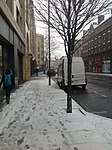Fenchurch Street
Harv and Sfn no-target errorsStreets in the City of LondonUse British English from December 2016

Fenchurch Street is a street in London linking Aldgate at its eastern end with Lombard Street and Gracechurch Street in the west. It is a well-known thoroughfare in the City of London financial district and is the site of many corporate offices and headquarters. The name "Fenchurch" derives from the Latin faenum (hay) and referred to hay markets in the area.To the south of Fenchurch Street and towards its eastern end is Fenchurch Street railway station, a mainline terminus with services towards east London and Essex. Other notable sites include the commercial buildings at 20 Fenchurch Street and 30 Fenchurch Street (formerly known as Plantation Place).
Excerpt from the Wikipedia article Fenchurch Street (License: CC BY-SA 3.0, Authors, Images).Fenchurch Street
Fenchurch Street, City of London
Geographical coordinates (GPS) Address Nearby Places Show on map
Geographical coordinates (GPS)
| Latitude | Longitude |
|---|---|
| N 51.511944444444 ° | E -0.080777777777778 ° |
Address
The Upper Crust
Fenchurch Street 52
EC3M 3JY City of London
England, United Kingdom
Open on Google Maps










